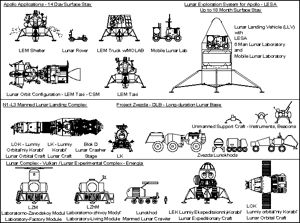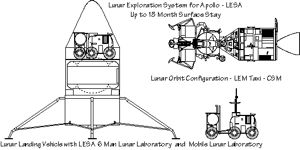
Home - Search - Browse - Alphabetic Index: 0- 1- 2- 3- 4- 5- 6- 7- 8- 9
A- B- C- D- E- F- G- H- I- J- K- L- M- N- O- P- Q- R- S- T- U- V- W- X- Y- Z
LESA Lunar Base

LESA Lunar Base
Credit: © Mark Wade
AKA: Lunar Exploration System for Apollo. Status: Cancelled 1968.
LESA would use a new Lunar Landing Vehicle to land payloads of from10,500 kg to 25,000 kg on the lunar surface with a single Saturn V launch. Extended CSM and LM Taxi hardware derived from the basic Apollo program would allow crews to be rotated to the ever-expanding, and eventually permanent lunar base. A nuclear reactor would provide power.
Evolution to a lunar base would go from the basic Apollo hardware to AES (Apollo Extension Systems) to ALSS (Apollo Logistics Support System using the LEM Truck), and then ultimately to LESA (Lunar Exploration System for Apollo). Modules developed for ALSS or LEM Truck could be used in LESA systems for commonality and to reduce development costs. The end result would be ever-expanding permanent stations on the moon.
A typical vision of post-Apollo lunar exploration envisioned the following phases:
- :
- 2 men/2 days - Apollo
- 2 men/14 days - AES - LEM Shelter (2050 kg surface payload - LEM Shelter)
- 2 men/14 to 30 days - ALSS with shelter or MOLAB (4100 kg surface payload)
- 3 men/90 days - LESA I (10,500 kg surface payload)
- 3 men/90 days - LESA I + MOLAB (12,500 kg surface payload)
- 6 men/180 days - LESA II with shelter and extended range roving vehicle (25,000 kg surface payload)
In a comparison lf lunar base approaches, the basic Apollo hardware scenario for thorough exploration of a single location would consist of a single manned lunar reconnaissance landing of the selected base site, followed by six Apollo launches over the next six quarters - total, 14 man-days on the moon for 7 Saturn V launches. The AES or ALSS approach would follow the single reconnaissance flight by three pairs of cargo landings and manned landings, resulting in a total of 86 man-days on the moon for the same number of Saturn V launches. The LESA approach, with a cargo lander followed by two manned landings in sequence to the same large shelter and rover, would allow 542 man-days on the moon. ALSS development would cost around $500 million, and LESA cost $1.45 billion. In terms of cost per man-day on the moon, either approach would pay off on the very first mission.
For LESA a "clean sheet of paper" direct lunar lander, the Lunar Landing Vehicle (LLV) was conceived, which would take full advantage of the Saturn V trans-lunar payload capability. The LLV would have a payload of 12,700 kg, which would include life support systems and consumables, a shelter, and a Lunar Roving Vehicle. The shelter was designed for six crew, but only three would use it in the early missions. It consisted of an airlock, a cylindrical domed center structure, and an outer toroid work area. Adequate space existed in the toroid for suited astronauts to function and operate the controls in case of an emergency depressurization. Net LLV translunar injection mass was 41,000 kg (equivalent to a 43,000 kg mass payload for the Saturn V, including fairings). Landed mass was 18,000 kg, including 11,5000 to 13,500 kg payload (depending on whether a one or two stage LLV was developed), 900 to 1,000 cu m of living area, and access platforms 1.6 to 3.0 m above the surface, depending on the staging concept. Engines for the LLV would be modifications of the RL10-A3 Lox/LH2 engine.
A nuclear reactor based on SNAP technology would power later LESA bases, producing 100 kWe to 200 kWe, with a mass of 11,700 to 13,500 kg, including integral shielding (it would not have to be buried under regolith). Tube radiators folded within the nose fairing during flight and deployed after landing on the surface. It would have to be located one to two kilometers from the shelter to keep personnel radiation doses within acceptable levels. The reactor would have a 10,000-hour lifetime and was expected to be ready by the mid-1970's. Landed atop a 4.72 m - 5.59 m diameter LLV stage, it would have a basic height of 2.54 m, a diameter of 6.22 m, and a height with the radiators folded of 8.89 m.
A comparison of the merits of various modes of building up the base on the lunar surface indicated that the least costly base to deploy would involve leaving the modules on their lunar landing vehicles, and having integrated meteoroid shielding on the modules rather than towing them off the landing vehicles and burying them under lunar soil. However this least-costly base also involved burying the reactor so that it could be located nearer to the base and not interfere with operations by imposing a 3 km radius 'no-go' zone around it. Finally NASA concluded that it would still be preferable to remove the elements from the landing stages and cluster them closer together so that the various shelters would be accessible to one another in a shirtsleeve environment.
One aspect of lunar communications noted early was that the moon's small size made line-of-sight communications between the base and rovers unfeasible beyond 30 km from the base. The best solution seemed to be to accept relay of communications from earth, despite the 3-second delay involved.
First generation rovers would be similar to MOLAB, a driving cab towing a fuel trailer. This would have a range of up to 300 km. Emergency return in the even of breakdown would be using a Lunar Flying Vehicle. Later more elaborate expeditions would use rovers consisting of two cabs from the earlier design, joined to tow a larger fuel trailer. This could range up to 800 km. In case of breakdown, one of the cabs, with its own fuel supply, could be separated and driven back to base. For additional redundancy, the rovers would travel in pairs.
LESA would provide the payload to allow a 90-day exploration mission by thee astronauts, including 1500 miles of exploratory traverses. An early target would be the Kepler region, with the base located southeast of the crater. First the LESA would be landed on the surface. A second Saturn V launch would deliver three astronauts to the landing site aboard a LEM Taxi. They would place the LESA shelter in operation, install a semi-permanent geophysical monitoring station, and deploy the roving vehicle. Two of the crew would embark on an exploratory traverse while the third remained at the shelter. Three or more such traverses would be undertaken during the mission, covering 14 geological features of interest as much as 400 km from the base. Later Model 4 LESA systems would allow an 18-man installation to be built, manned over 24 months by a series of 8 Saturn V launches.
Crew Size: 6.
Family: Lunar Bases, Moon. Country: USA. Spacecraft: Apollo CSM, Apollo LM Taxi, Molab, LESA Shelter, LFV North American, LLV. Launch Vehicles: Saturn V. Bibliography: 2331.
 | LESA Shelter Credit: © Mark Wade |
 | LESA Lander Credit: NASA |
 | Lunar Exploration Lunar Exploration Plans Credit: © Mark Wade |
 | Post-Apollo lunar Comparison of American post-Apollo lunar spacecraft. Credit: © Mark Wade |
 | LESA Lunar Base Credit: © Mark Wade |
Back to top of page
Home - Search - Browse - Alphabetic Index: 0- 1- 2- 3- 4- 5- 6- 7- 8- 9
A- B- C- D- E- F- G- H- I- J- K- L- M- N- O- P- Q- R- S- T- U- V- W- X- Y- Z
© 1997-2019 Mark Wade - Contact
© / Conditions for Use